Creating and publishing ads is easy. Getting people to see and click them? Not so much.
If you're like most, you've used Google Ads to promote your products and services, but struggle to get a high click-through rate (CTR).
Wondering whether Dynamic Search Ads (DSAs) are the answer to your online advertising prayers? You're not alone. DSAs are widely used to personalize ads with the help of AI.
They certainly can be the answer to your online advertising prayers...but they also might not. We're going to explain what DSAs are, what makes them good (and bad), and how to set them up.
Get brand new Google ad strategies straight to your inbox every week. 23,739 people already are!
Why use Dynamic Search Ads?
Ideally, Dynamic Search Ads better target your ads to ideal users. This can increase the relevancy and click-through rate (CTR) of your ads. When your CTR boosts, it also helps your ad's quality score and ranking.
This improves ad placements, driving more qualified traffic to your website. Now it's up to your landing pages to convert.
Let's review what DSAs are.
What are Dynamic Search Ads (DSAs)?
DSAs use Google's advanced crawling technology to comb your website content for relevant search terms to target and use in your ad targeting and ad copy.
Google's defines them as:
“Ideal for advertisers with a well-developed website or a large inventory, Dynamic Search Ads use your website to target your ads and can help fill in the gaps of your keywords-based campaigns.”
This doesn't mean DSAs are only for eCommerce sites with a large inventory for Google to index. You can use Dynamic Search Ads effectively, so long as you know what services to emphasize and what pages to direct your traffic towards.
For example, if you're a PPC agency running Dynamic Search Ads, and a user searches "PPC agency pricing models," it's possible Google will show your DSA and send them to a blog post you published titled The Pros And Cons Of Different PPC Agency Pricing Models.

Or, if you've specified your DSA campaign to send traffic to key service pages, it could send that user directly to your pricing page.
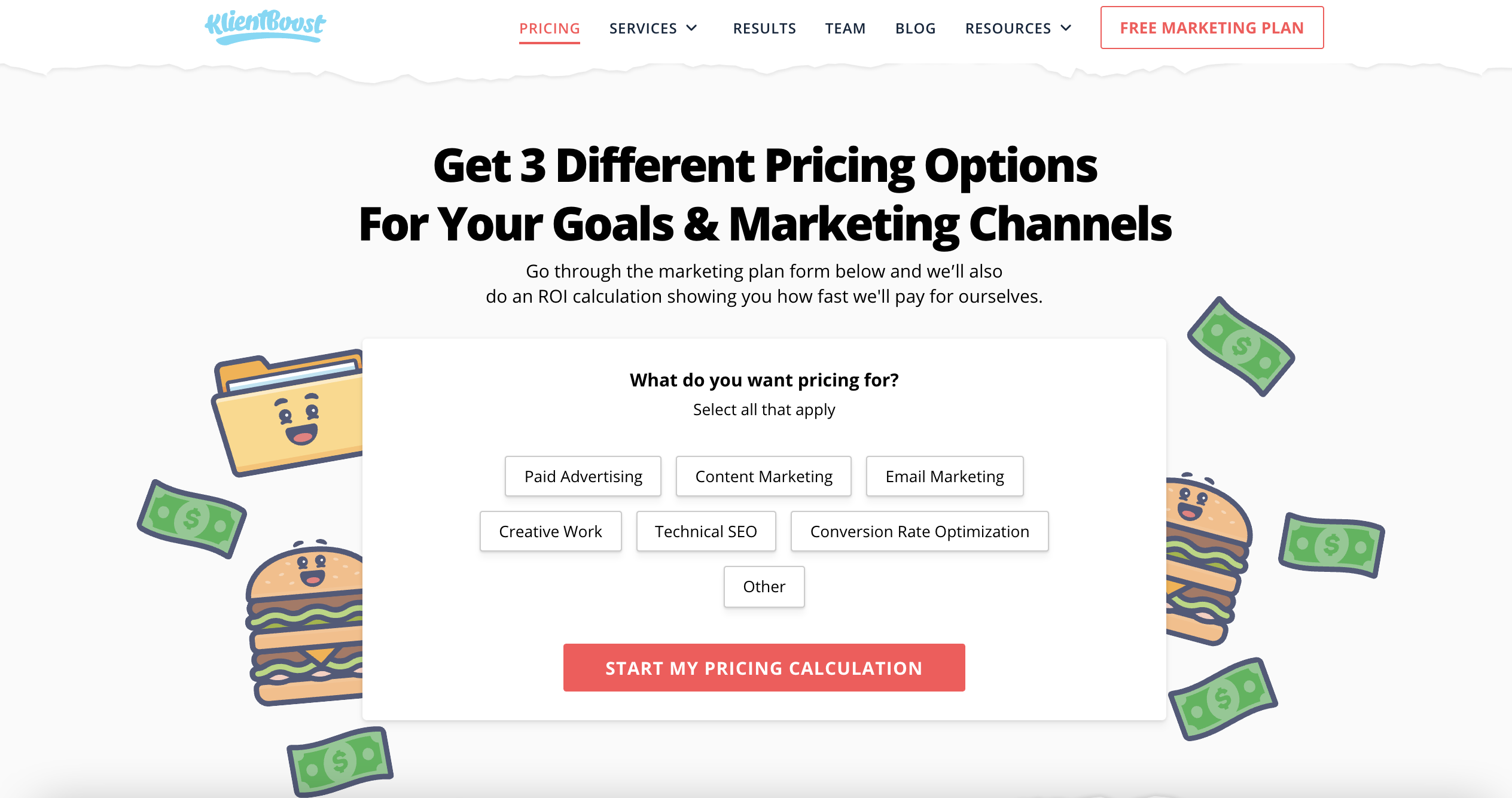
As you can see, very different customer experiences come with each page.
Dynamic Search Ads are all about sending the most relevant traffic to the best-suited landing page. But the key to their success relies on how well you use them to attract ideal customers, and how strategically you can manage the traffic that your DSAs generate.
How Dynamic Search Ads work
Dynamic Search Ads automate your ad copy and format. They pull content directly from your site that Google believes will appeal to the searcher. For instance, if a user is looking for "women's nightgowns," it'll select an image of women’s PJs from your website and generate an ad headline like "Best Women's Nightgowns" to attract a click.
Instead of keywords, Dynamic Search Ads know who to show ads to based on your dynamic targets. These targets can be categories, specific pages on your site, or even all pages of your site. When your targets are website-based, Google’s site crawling technology identifies what search terms are best to show your ad for based on the content of your website.
Ad headlines generate based on the targeted user's search terms, which increases the odds of a click-through. Display URLs also dynamically generate based on the same criteria.
The landing page your ad will use is chosen dynamically by Google to best fit the search query and depends on your dynamic targets. For example, if you’ve chosen specific pages on your site as targets, Google will only select one of those pages to send your ad to. Or, if you’ve chosen a category or all webpages as a target, Google could choose any relevant landing page on your site to send your ad to.
The only thing you’ll need to contribute manually to a dynamic search ad is your description 1 and description 2.
To make your ads more efficient, keep the titles and headlines on your site between 60 and 90 characters. It's also ideal to have unique CTAs to target specific user groups.
How to set up Dynamic Search Ads
Setting up Dynamic Search Ads is simple. Here are the steps to get started:
Log into your Google Ads account. Go to your dashboard and start a "New Campaign."

Select the type of campaign you want to run:
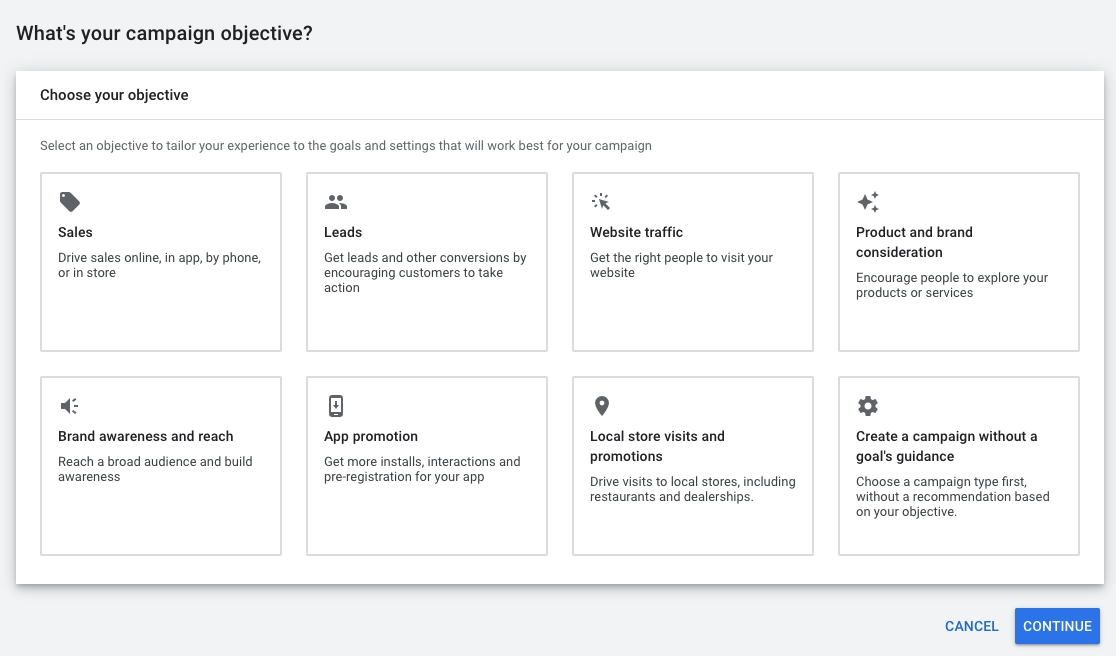
Next, you’ll choose the type of campaign you want to run:
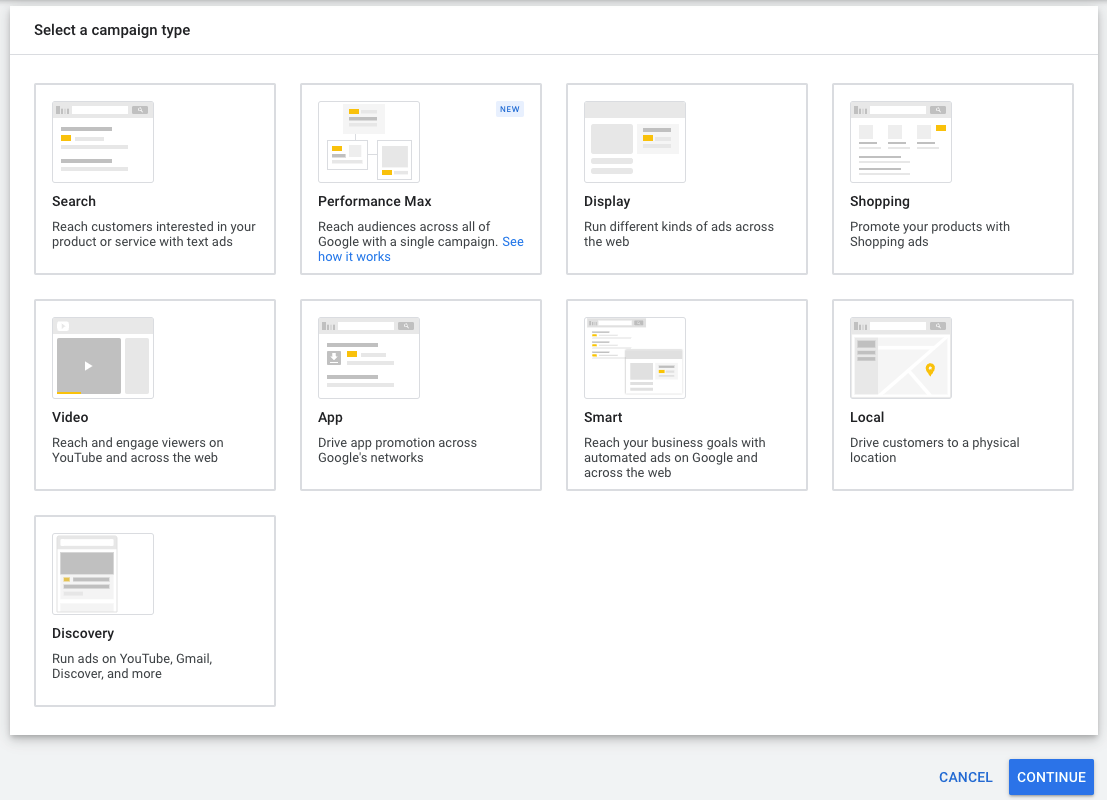
In the next screen, you’ll select your conversion goals (i.e., phone calls or form submissions). It’ll have default settings, but you can change them as needed:
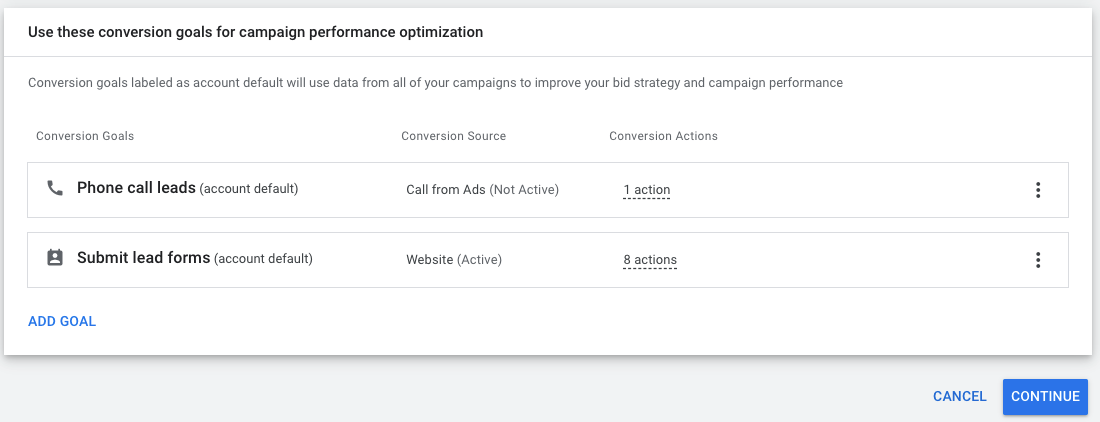
Click continue, and then you’ll select the results you want to get from your campaign. Choose between the three options, and then name your campaign:
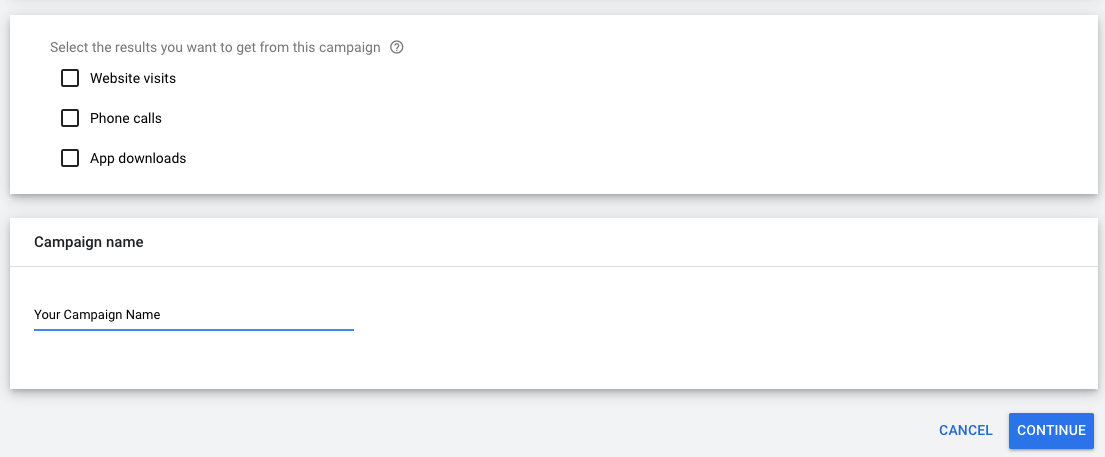
Now, it’s time to set your budget and bidding strategy. Let Google know your focus (i.e., conversions, clicks, impressions) or select your bid strategy directly. If you want to adjust Ad Rotation settings, then open “More Settings”:
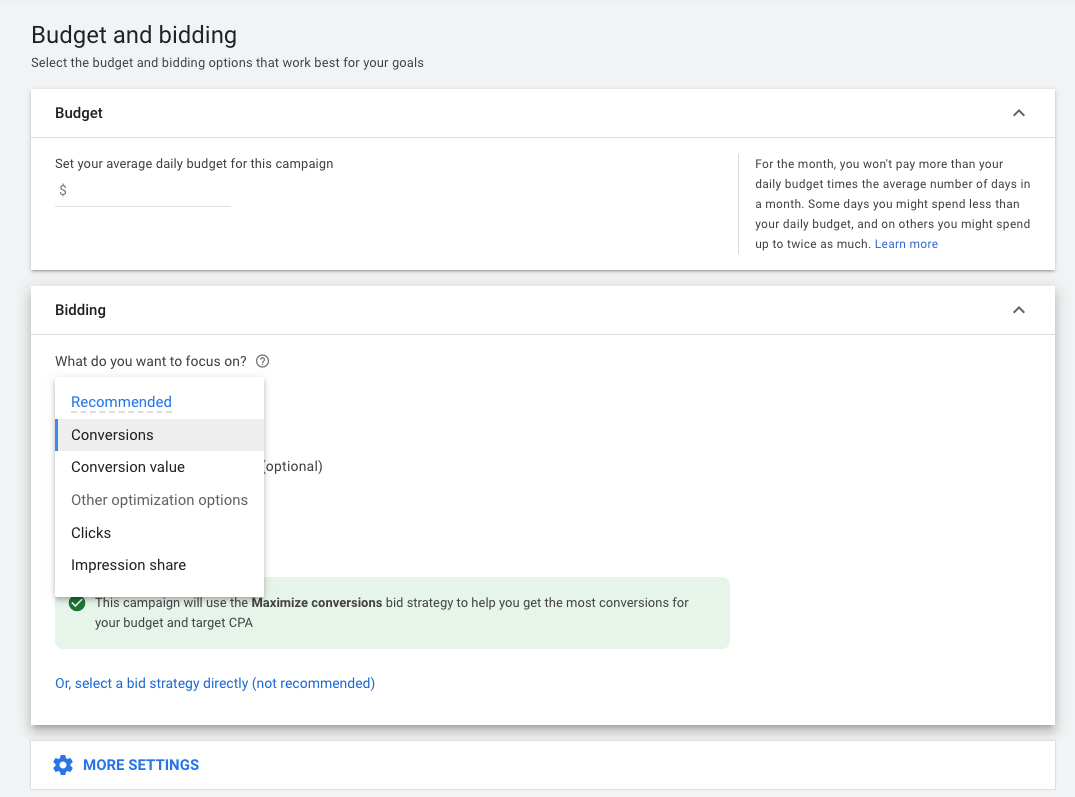
In the next screen, click the box under “Search Network” and choose the locations you want to target:
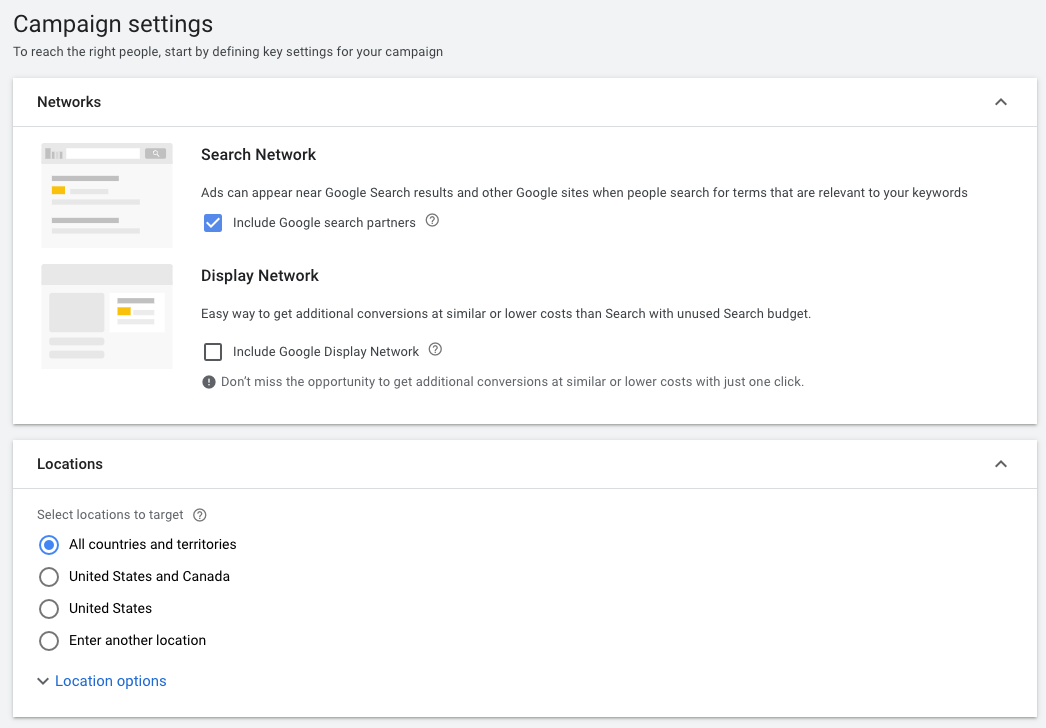
Then decide which languages you’ll target and the audiences you want to segment (if applicable):
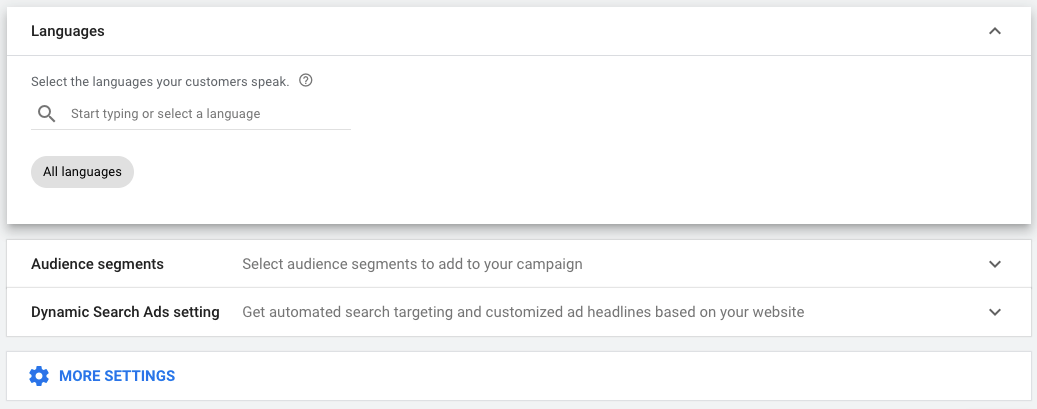
Next, open the Dynamic Search Ads setting and enter your site domain without the https:// or www. Then choose the language of your DSAs and select “use Google’s index of my website.”
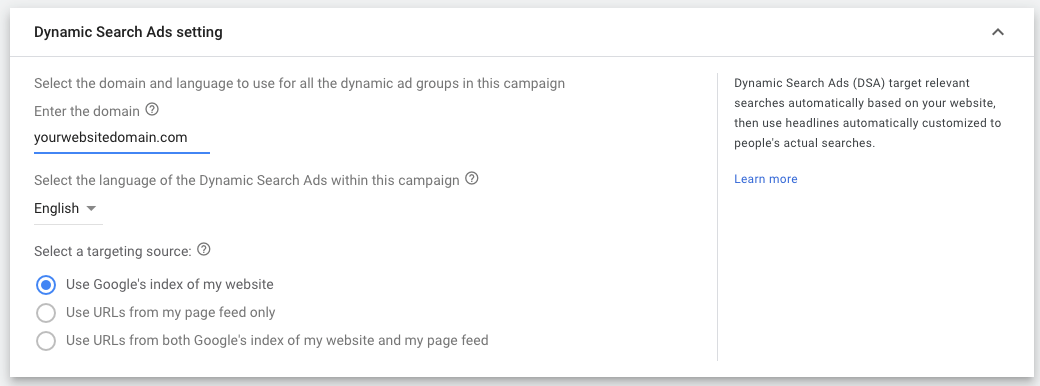
If needed, open “More Settings” to select your ad schedule, start/end dates, or input campaign-level URL tracking options. Once you’re done, click next.
Now, it’s time to create your dynamic ad targets. But you don’t need to select a target in each type. Just select one target option, if that’s all you want.
If you’re going with categories, choose the categories of your ad targets. Look through the options and check the boxes:
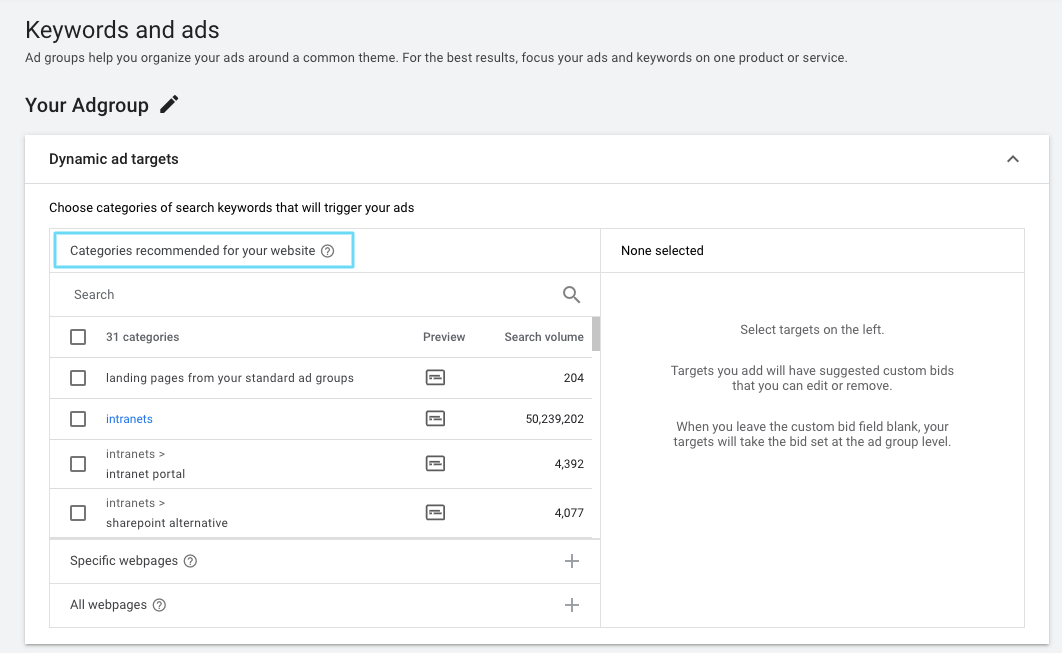
If you have a specific webpage you want to link ads to, then add the URLs here. Make sure to click the “Add” button to ensure all the URLs are included as dynamic targets.

If you don’t want to add exact URLs, you can select “Create rules to target webpage” instead. Be sure to click the “Add” button to ensure your targeting rules are included.
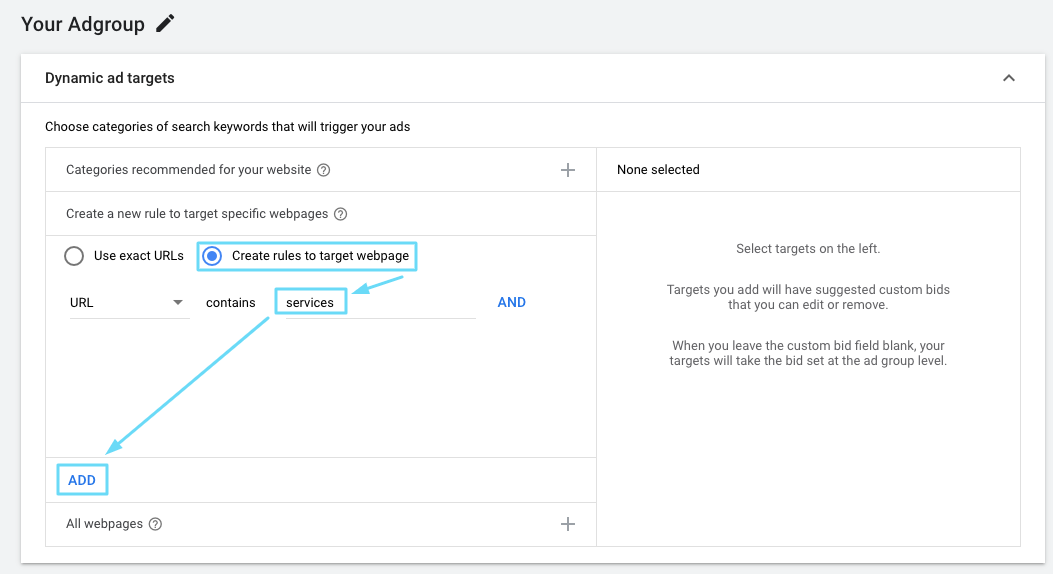
There are other options for rules you can choose aside from URL contains, like Page Title Contains or Category equals. Then the AND function allows you to create rules for URLs containing more than one term. For example, if you want to target URLs that contain both the words “services” and “PPC.”
If you don’t want to target a specific webpage, you can check the box for “All webpages.” Then scroll down to the ad creation section and create the ads for this ad group.
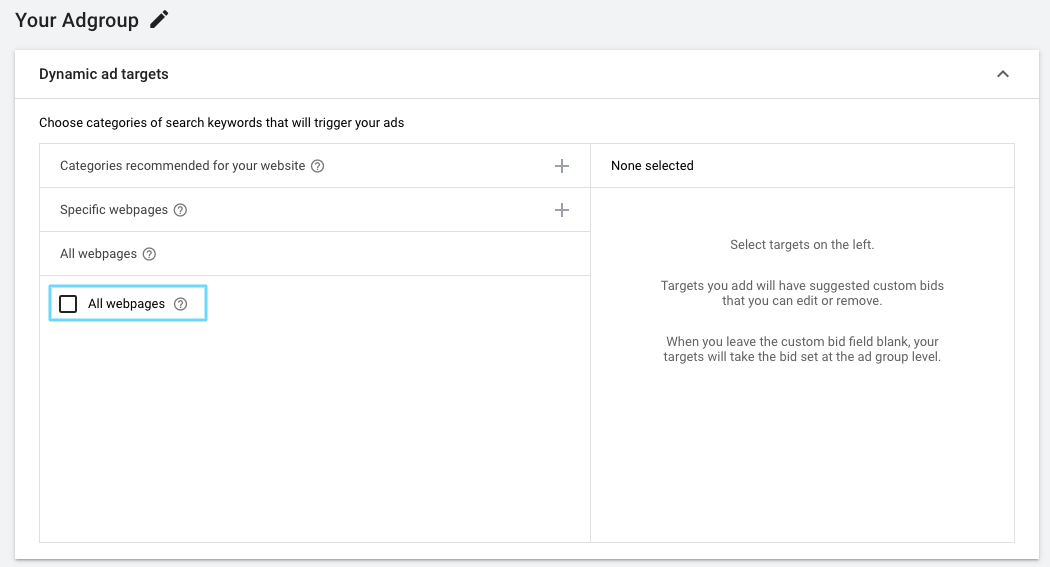
Now, it’s time to create your dynamic search ad descriptions. Type two variations of your description, include URL options (if needed), then click “Done.”

A small preview of your ad will appear—if everything checks out, you can either create another ad in this adgroup, or create another ad group (and associated ads), or click “Next.”

Next, you’ll choose specific extensions for the campaign. Or opt to use your account level extensions (if you have any). It’s recommended to use extensions, but they’re optional.
Once you’re finished, click “Next.”
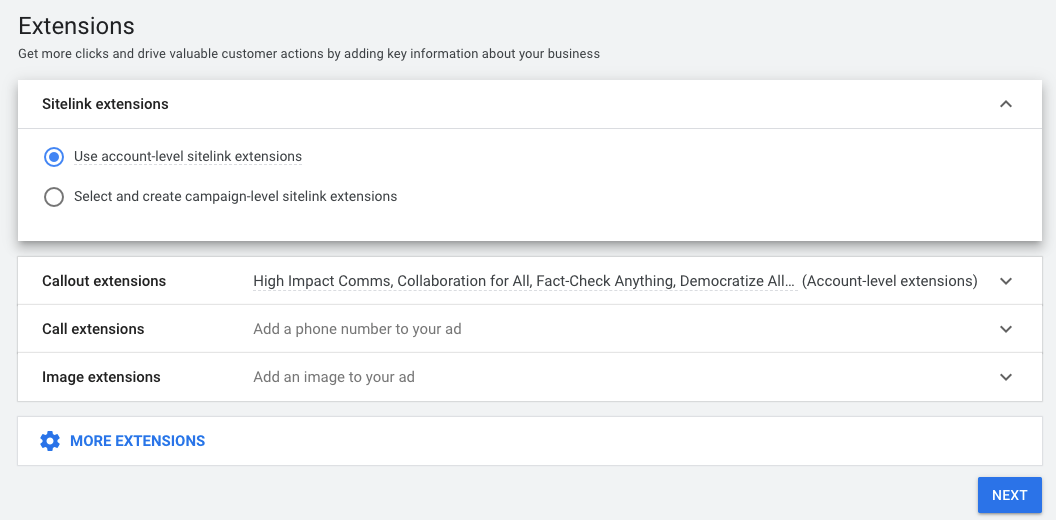
Now, you’ll see any errors with your ad campaign that require fixing before it can be published. Once you correct them, click “Publish Campaign.”

Dynamic Targeting Options
How you set up each DSA campaign matters. So you’ll have to decide which dynamic targets make sense for your campaign. Here’s a look at the differences and benefits of each.
Categories
Setting up categories for your ad campaigns makes sense if your website has various sections. For example, if you’re a home remodeling company, then you may have categories for kitchen remodeling, bathroom remodeling, and so on.
Google will pull up categories based on your site map.
It takes more time to set it up, but will provide greater control over what visitors see on your site. You can change bids based on the priority each category has to you.
Specific webpages
You have the option to target all pages on your domain to allow Google to crawl your entire site for relevant content to show on your ads.
However, this is an extremely broad net to cast and goes directly against the golden tenant of PPC landing page CRO: using dedicated landing pages for dedicated traffic and search intent(s).
On the flip side, you can target only certain pages within your domain with your DSAs. For example, if you have key service pages or pricing pages you want to send traffic to, this will optimize two birds with one stone.
To target specific pages within your site, go to Advanced Settings and select "Target Specific Webpages."

You can enter up to 20 web pages.
Alternatively, you can create one or more rules to specify what types of pages within your domain towards which you want to send potential ad traffic. Below are the rules available to implement:
- "If URL Contains"
- "If Page Content Contains"
- "If Page Title Contains"
- “If Category Equals”
So, for example, if you want your campaign to target only pages with “How To” in the title, you would select the “If Page Title Contains” rule and enter “How To” in the available text box.
All webpages
Low on time and don’t mind relinquishing control over your campaigns? Then targeting all web pages grants the fastest setup. Google will match the keywords to the content of your pages to show the most relevant pages to searchers.
But be careful, they may land on a blog post instead of a product or landing page. There’s also one bid option, so there’s no way to adjust bids for higher-performing pages.
When to use Dynamic Search Ads
Dynamic Search Ads aren't for every type of campaign. Yes, they can work across the board for search network advertising. But that doesn't mean flood your campaigns and ad groups with new and over-indulgent DSAs.
There's a reason DSAs are only for the search network: they're meant to capitalize on the high conversion intent associated with the Google Search Network.
Capitalizing on high intent from search
Google Search Network (GSN) has a high level of conversion intent compared to other channels like social media, the Google Display Network (GDN), or other email remarketing campaigns.
Unlike other channels, where users see ads related to their general search history and behavior, the GSN relies on their specific intent.
What does all this fancy jargon mean? It means the traffic coming through the search network is "hotter" than any other channel.
AKA: It's safer to assume a user searching for your keywords (products/services) via the search network is looking to convert on some level.
This is why identifying the difference between the two is important.
Dynamic Search Ads should capitalize on this higher intent by taking your ads from relevant to hyper-targeted. The more targeted and relevant your ads, the better you can reach your potential clientele.
Google rewards you when you match keywords to actual user search queries. This is the same logic behind DSAs—the better you cater your ads to what users are searching, the more satisfied they'll be. This means more clicks and traffic for you, and more money for Google.
Everybody wins.
Customizing your ads to user search queries
If you haven't heard the news by now, read about what we call the Iceberg Effect here at KlientBoost. The Iceberg Effect describes the distinction between targeting keywords in the GSN versus the actual user search queries that trigger those keywords. Below are the definitions of the two to help distinguish.
Keywords, according to SEJ, are:
“A keyword is the exact term that you are targeting in a paid search or organic search campaign. If you want to win a PPC bid for the term “house paint”, then “house paint” is your keyword.”
Where Search Queries, are:
"Queries are what the user types in. They are searching for something online, and they type stuff in Google, speak something to Siri, or otherwise perform a search. It's called a query."
The Iceberg Effect outlines how, in most cases, when you're targeting Keywords you're actually dealing with a large array of search queries. And this is a terrible thing.
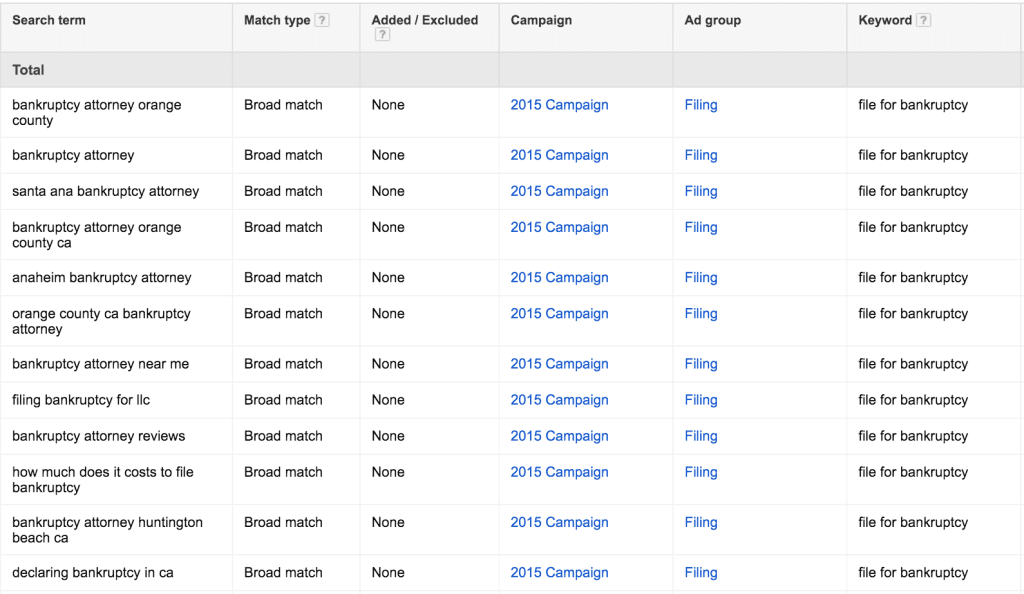
Just look at all these potential searchers, many of which are irrelevant to your ads.
The inefficiency of wide nets
Let me be very clear: This is nothing like "efficiently" casting a wide net. It's the opposite.
In the PPC world, you pay for every click on your ad. So you only want clicks from interested users who find your ad relevant and interesting—those looking to convert.
The logic behind this is simple: if you're generating lots of traffic from irrelevant clicks, then you're paying a lot of money without generating revenue.
That's some math that nobody wants to do.
A Keyword:Search Query Ratio that is severely out of balance is akin to a massive iceberg as you see in the graphic below.

That's a brutal ratio, eh?
The more you can pare down your disparate icebergs into smaller, more targeted icebergs (with Keyword:Search Query Ratios closer to 1:1), the better.
Here at KlientBoost, we use the SKAGs technique to create a perfect 1:1 ratio and guarantee targeted relevant ads.
But for brands looking to optimize on the go, while gaining some perks of SKAGs without the intensive setup, Dynamic Search Ads offers a very similar solution.
Dynamic Search Ads have the unique ability to adjust search terms they're shown for and the copy within the ad. Google created an ad function in Google Ads that is attempting to automate the logic behind SKAGs.
DSAs are constantly trying to improve your Keyword:Search Query Ratio to keep it close to 1:1 at all times.
Increasing CTR (and therefore quality score)
Improving your ad relevance with DSAs that have a strong Keyword:Search Query Ratio can significantly boost your CTR (Click Through Rate).

The more targeted your keyword (closer to the search term) the higher the CTR should be.
That's right. Using DSAs improves your CTR by enhancing the relevancy of your ads based on ad copy and when it shows. What's better than an improved CTR? An improved Quality Score because of boosts in relevancy and CTR.
Now, Quality Score is a bit of a black box in the PPC world. But we know that improving your Quality Score helps your ads perform better. It improves the average placements of your ads in the GSN and lowers your CPC (Cost Per Click).
These stem from increasing your CTR while maintaining a strong landing page experience. This is easy to manage if you're using DSAs correctly and sending traffic to relevant pages.
It's not about randomly increasing your CTR with irrelevant traffic that devastates your ad spend and PPC budget. DSA does the opposite.
Dynamic Search Ads improve your CTR with more relevant traffic. Then it's just a matter of you converting.
Pros and Cons of Dynamic Search Ads
Using DSAs is a good idea to promote your product or service. But as with any marketing technique, there are downsides—some are preventable, while others are outside of your control.
Let's begin with the pros.
Pros
One of the top reasons advertisers use Dynamic Search Ads is because they're a timesaver. Once you build your ad groups, they self-generate headlines and content to display to targeted users. It's almost a set-it-and-forget-it approach (not recommended, by the way).
Plus, Google pulls relevant data from its organic search index, which reduces your time spent selecting keywords, bids, and ad copy for each product or service.
It reduces your overall workload once you iron out your strategy and copy. Then because they appear to a wide audience across websites and search engines, you increase the odds of clicks and conversions.
DSAs complement your current keyword-based campaigns, which further increase your visibility and traffic potential.
These ads also feature longer headlines, which are ideal to capture attention and interest. And you have to love the personalized ad approach, which means your ads are more likely to hit home with searchers. Each ad contains offers and information they need in the format they're most likely to consume.
Cons
The downside of DSAs can be detrimental to your budget and overall campaigns, if you're not careful. For instance, if you're focusing solely on Dynamic Search Ads, then your campaign may suffer a bit. This is because you're targeting a broad audience vs. narrowing it down with high-value keywords.
In other words, your CTR and conversion rate may not be as great using DSAs only.
Also, since DSAs pull content from your landing pages, it's possible it'll use irrelevant search terms for your particular audience. So there's a possibility of mismatched headlines and ad copy.
These problems persist when your website SEO structure isn't good. Proper SEO structure makes it easier for Google to pull data from relevant product pages based on search queries.
Not having complete control of your ad campaigns is one of the biggest pitfalls of DSAs. However, you can counter this by adding a list of negative keywords to reduce mistakes.
How to Optimize DSAs
Now, we've discussed the pros and cons of using Dynamic Search Ads and the different instances in which you should use them. We've even discussed their basic functionality and what problems Google is attempting to solve with DSAs.
But now it's time for the real fun stuff: how do you optimize your DSAs for the best results? Here are five Dynamic Search Ad best practices to help you optimize your already hyper-relevant ads.
1. Use supplemental/informative content
When creating your ad descriptions, always keep “ad empathy” in the back of your mind. Putting yourself in the shoes of the viewer makes you stand out from competing ads.
Choose information that stirs curiosity, touches on their needs, or highlights something unique. Showcasing your company's amazing Google rating, for example, is both unique, trustworthy, and leaves the consumers asking “why?” Don't worry about finding the unicorn of sentences with all the points, that's what A/B testing is for.
Remember, you're choosing text to increase your CTR, so select text with an empathetic mindset to nudge the viewer into clicking on the ad.
Try asking yourself these three questions:
- “What would I want to know?”
- “What's so special about this company?”
- “Why is it better than other companies?”
All the information should be in the description section since the headlines are auto-filled.
2. Related services/products
Obviously, you'll want to include the product and service at hand. Most likely, the search query will contain the product or service, which inserts the product/service into the ad's headlines. But sometimes you can clarify and take it a step further.
For example, general search queries that include words like, “services,” “products,” or “items,” can be explained. Let's say you're a steam cleaning company, bidding on a keyword like “steam cleaning services.” In your description, clarify and include key services like, “carpet cleaning,” “tile and grout cleaning,” and “drapery cleaning.” Try including these in a structured snippet extension—it's always worth testing.
3. Focused call-to-action
High-performing landing pages have a clear, focused call-to-action (CTA). Fixating on the value entices visitors and may lead to great conversion rates.
You can also translate this idea into DSAs. The ad should contain the same CTA you'd find on the landing page, so the visitor sees consistency. Offering value or an incentive could be the deciding factor as to whether someone clicks on your ad.
- “Family Owned Since 1976”
- “Get Your Free Custom Quote Today”
Which CTA sounds more enticing? The second phrase gives the viewer added value the first phrase lacks.
If we're speaking about ad empathy, the free consultation shows the company isn't trying to push a sale onto them. Instead, they're willing to win them over with their time and expertise.
Remember that the only part of the ad you can manage yourself is the description in the ad. So if you're looking to control your CTA testing within a DSA campaign, you'll have to keep your CTAs in your description.
4. Be wary of overusing buzzwords/jargon
We're all aware of “buzzwords” in the marketing industry. Business marketers have been sprinkling them over their copy for years. As a result, we're left with words that initially seem like a good idea, but actually have run themselves into a black hole of desensitized marketing techniques.
Today, consumers can tune out marketing chatter. They can recognize when a word or phrase has little to no meaning, especially when it's overused. The ad's content quickly goes from trying to sound unique, to sounding generic and uninspiring.
Here's another example.
- “Get A Free Consultation”
- “Get Your Free Custom Quote Today”
Both phrases have essentially the same message, but a free consultation is overused and may not have the same impact.
Try looking at these phrases:
- “Increasing Customer Satisfaction”
- “Innovative Solutions”
The first buzzword “customer satisfaction,” holds little to no value when customer happiness is essential for any business. After all, there isn't a business in existence that doesn't value happy customers.
The second buzzword “innovative,” holds no significance. What does that mean to the consumer? Without context or evidence, it's nothing more than business jargon.
Instead, try simple meaningful word choice and alternative copy. This will attract attention for the right reasons.
5. Filter which pages use DSA on your site
If you have a variety of landing pages and want to implement DSAs, then choose “juicy” pages.
Well, how do you know what is or isn't a juicy page?
Look for specific pages containing an array of different copy Google sees a demand for. Google will use web crawling algorithms to scan your page and choose which search queries to show ads for.
If Google scans a return policy page, they might not find the best search queries with text describing the product or services needed. A juicy page will contain an informative description copy.
In this case, you'll want to use the “Target Specific Webpages" technique mentioned earlier. This way you'll control which pages the DSA ads can crawl leading to the best results.
Wrapping Up
Display Search Ads come with their trials and errors. But it's up to you to experiment with different strategies to see what works.
With this guide, you have the steps needed to create DSA campaigns to improve CTR. If you'd like to learn more about different types of ads, then check out "The Case For Expanded Text Ads: What You Need To Know".